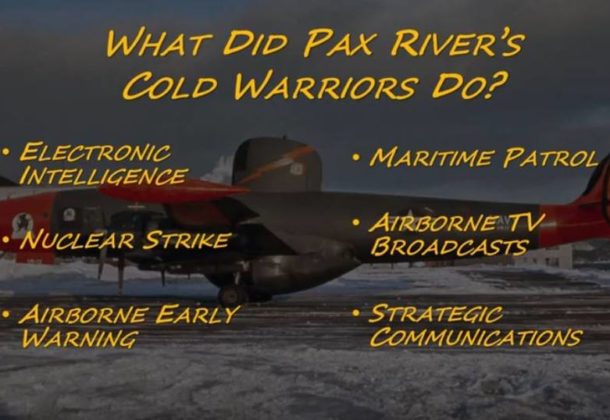Pax’s Cold War Warriors Remembered

By 1948, World War II was over and many in the very rural St. Mary’s County thought the Patuxent River Naval Air Station would begin to dwindle in importance, perhaps disappear entirely. And while it might have appeared from outside the gate that activity had slowed, that was far from the story inside.
Between 1948 and 1970 some of the most important and dangerous work of the Cold War and beyond was being performed at and out of Pax River.
Although renowned as an aircraft test facility, Pax River is also the home port of a number of fleet squadrons, says St. Mary’s County Historical Society’s Executive Director Peter LePorte as he introduces the inaugural presentation of the Historically Speaking series, “Pax River’s Forgotten Cold War Warriors.”
Only three squadrons ever deployed to carriers, explains Bob Tourville, a historical researcher and exhibit designer with Patuxent River Naval Air Museum who became interested in the history of the fleet squadrons. In the video below, Mr. Tourville presents a broad, but also detailed history of squadrons operating during the Cold War along with photos of many of the aircraft and technology involved in the variety of missions out of Pax River.
Mr. Tourville retired from NAVAIR in 2014 after a 35-year career as a systems engineer and volunteers now with the museum, which is where he presented his in-depth research on the six areas where Pax River contributed to protecting Americans during the Cold War.
Some of the squadrons were “mission-operational” he explains and many had dangerous assignments. These squadrons conducted hazardous surveillance missions, played pivotal and ongoing roles in retaining communication functions in the case of a nuclear strike, patrolled and guarded the coast of the United States.
“A lot happened right here at Pax River.” Lives were lost, some without the nature of their mission disclosed at time of death. It took a quarter-century for the Navy to be able to acknowledge the loss of eight aircraft and 81 lives during this era. All told, 400 Americans lost their lives on intelligent missions. “The Cold War was not very cold at all,” Mr. Tourville says.
And not all of the missions inaugurated during that era have retired, some are still here. “The threat of nuclear war remains,” Mr. Tourville says. “I don’t think I have to say anything more about that.”
Mr. Tourville wraps up his presentation noting that some of these Cold War warriors were only transients through Southern Maryland, some stayed, and likely descendants of the Cold War warriors remain in Southern Maryland. “But for some, Pax River is the last place they called home. I think we should remember them.”
This inaugural presentation of the Historically Speaking series also initiates an effort by the Historical Society to bring more of Pax River’s history to the fore, recognizing its significance in Southern Maryland. As with the hosting of this video, the Patuxent River Naval Air Museum was a willing partner. Museum Director Amy Davis and the audio-video expertise of Pete Butt were instrumental in partnering with St. Mary’s County Historical Society to produce the video. Support was also received from the Southern Maryland Heritage Area and Maryland Heritage Areas Authority.
The Historical Society is the repository of a unique collection of Maryland memorabilia and museum pieces displayed on the first floor of Tudor Hall and in the Old Jail Museum at 41625 Courthouse Drive in historic Leonardtown. The 18th-century Tudor Hall also serves as headquarters of the society and houses the Historical Society’s Research Center.
To learn more about the St. Mary’s Historical Society, visit its Leader member page.






















